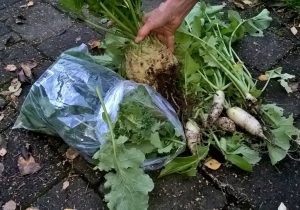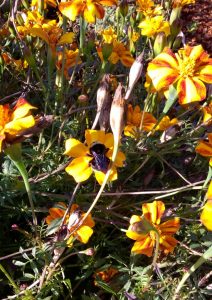Harvest Highlights – Part I – Vegetables
November 30, 2016
The bounty from our seven vegetable gardens was spectacular and, beginning mid-May and  ending mid-November, we donated over 300 pounds of produce to the University District Food Bank. Thanks so much to experienced gardeners Sue Hartman and Nancy Helm, sluggers in the batting lineup with Team Mother Nature.
ending mid-November, we donated over 300 pounds of produce to the University District Food Bank. Thanks so much to experienced gardeners Sue Hartman and Nancy Helm, sluggers in the batting lineup with Team Mother Nature.
Nancy filled our spare garden bed with organic seed potato. With surplus compost, she periodically hilled up the potato rows. What a strategy! The potato harvest was huge and easy to dig up. Nancy was in awe of Sue’s beautiful greens: “Now I know that floating row cover is worth the effort, continuous harvest and cleanup helps prevent disease, and crowding plants is bad.”
 Indeed, Sue’s chard, kale, collards, lemon cukes, zucchini and tomatoes belonged in an art gallery. However, there was a bit of ugly. We came face to face with Spotted Wilt Virus this summer. (photo) Sue thought it would be easier to deal with determinant* tomatoes in cages (versus trellis). Indeterminate tomatoes do not appear to be susceptible to this disease and are less prone to splitting, so next year she will grow a row of indeterminate tomatoes instead. She also grew powdery mildew resistant summer squash but it did not sufficiently resist. We will try a milk spray early next year to keep the mildew at bay.
Indeed, Sue’s chard, kale, collards, lemon cukes, zucchini and tomatoes belonged in an art gallery. However, there was a bit of ugly. We came face to face with Spotted Wilt Virus this summer. (photo) Sue thought it would be easier to deal with determinant* tomatoes in cages (versus trellis). Indeterminate tomatoes do not appear to be susceptible to this disease and are less prone to splitting, so next year she will grow a row of indeterminate tomatoes instead. She also grew powdery mildew resistant summer squash but it did not sufficiently resist. We will try a milk spray early next year to keep the mildew at bay.
 We spoke to the produce manager at the University food bank to find out what their clients snatch up fast. In response, we have made more room for collards. We now drop off produce later in the week; early in the week, the food bank garners unsold produce from the weekend farmer’s market events.
We spoke to the produce manager at the University food bank to find out what their clients snatch up fast. In response, we have made more room for collards. We now drop off produce later in the week; early in the week, the food bank garners unsold produce from the weekend farmer’s market events.
I learned that tomatillo plants could sprout new plants from a branch lying on the ground. (This is ‘layering’. Blackberry plants are quite skilled at this type of propagation.) And, when homegrown radishes are too hot to eat fresh, they are mild and delectable when roasted. Early on, I was disgusted with the low germination rate of the French marigolds but I had to eat my words because it only took two plants to fill up a big space full of bee-friendly small flowers. (photo)!
We used less than one CCF (748 gallons) of City water this year. The rest of our water needs,  about 2,500 gallons, came from rain stored in the cisterns. We added only organic approved inputs including cardboard, donated compost and wood chips, burlap bags, agricultural lime, some blood meal, and fish fertilizer.
about 2,500 gallons, came from rain stored in the cisterns. We added only organic approved inputs including cardboard, donated compost and wood chips, burlap bags, agricultural lime, some blood meal, and fish fertilizer.
Gardeners note! Sue donated well-labeled seeds and they are in the shed for your use!
We welcome Mitch as our new gardener and we warmly bid farewell to Ryan who is moving out of Washington.
Ruth
* Determinant – plant stops growing when fruit sets on the top bud. Indeterminate – plant will grow and produce until it gets cold

I always learn so much from this! Thanks a lot, Ruth!